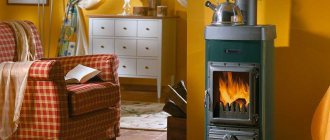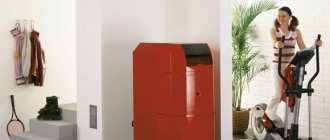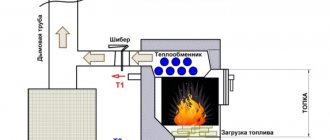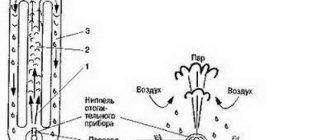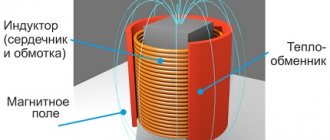With rising energy prices, the use of alternative energy sources is becoming increasingly important. And since heating is the main expense item for many, we are talking about heating first of all: you have to pay considerable amounts almost all year round. When you want to save money, the first thing that comes to mind is solar heat: a powerful and completely free source of energy. And it’s quite possible to use it. Moreover, although the equipment is expensive, it is several times cheaper than heat pumps. Let's talk in more detail about how solar energy can be used to heat a house.
Solar heating: pros and cons
If we talk about using solar energy for heating, then you need to keep in mind that there are two different devices for converting solar energy:
- Solar panels. They produce exclusively electric current. But you can already use it to ensure the operation of any electrical equipment, including the operation of heating devices.
- Solar collectors. These devices heat the liquid (coolant) and can be directly connected to the heating system, and can also be used to heat water for domestic needs.
This way you can provide your home with hot water and partial heating using solar energy.
Both options have their own characteristics. Although it must be said right away, whichever one you choose, do not rush to abandon the heating system that you have. The sun rises, of course, every morning, but your solar cells will not always get enough light. The most reasonable solution is to make a combined system. When the sun's energy is sufficient, the second heat source will not work. This way you will protect yourself, live in comfortable conditions, and save money.
If there is no desire or opportunity to install two systems, your solar heating should have at least a double power reserve. Then we can say for sure that you will have warmth in any case.
Advantages of using solar energy for heating:
- A safe and absolutely “clean” source of energy.
- Reduced heating and hot water costs.
- You are independent of the state of the economy: the sun always shines, both in crisis and in times of prosperity.
- The sun does not require money for its energy. Another thing is that the state can impose taxes on the owners of solar installations. But so far this has not happened - solar energy is free.
The sun constantly sends heat to the earth. And you can use it to heat your home
Flaws:
- Dependence of the amount of incoming heat on the weather and region.
- For guaranteed heating, you will need a system that can operate in parallel with a solar heating system. Many heating equipment manufacturers provide this possibility. In particular, European manufacturers of wall-mounted gas boilers provide for joint operation with solar heating (for example, Baxi boilers). Even if you have installed equipment that does not have this capability, you can coordinate the operation of the heating system using the controller.
- Solid financial investment at the start.
- Periodic maintenance: tubes and panels must be cleaned of adhering debris and washed from dust.
- Some of the liquid solar collectors cannot operate at very low temperatures. On the eve of severe frosts, the liquid must be drained. But this does not apply to all models and not all liquids.
Now let's take a closer look at each type of solar heating element.
How to choose a solar collector for heating
The production facility is actively involved in the implementation and development of energy-saving technologies based on solar vacuum collectors. Solar water heating installations of the ANDI Group brand are successfully used both at the domestic and industrial levels.
How to choose a solar collector for hot water supply and heating?
We suggest that you familiarize yourself with the production recommendations for choosing a solar water heating system for hot water supply (DHW) and heating of country houses, dachas and cottages.
Solar split systems can fully provide you with hot water supply (DHW), but cannot completely replace traditional heat sources for heating a room. They will definitely help you save the life of your existing boiler and the energy resources it consumes, such as gas, liquid or solid fuel, electricity (from 30 to 60% per year).
Selecting the volume of a solar water heater for hot water supply.
To provide hot water supply, you need to take into account that, as a rule, solar systems (due to their inertia) are installed at the rate of hot water consumption of 100 liters per person (with an average rate of 50-60 l/person per day for main systems of apartment buildings ). The power of a standard 300-liter system will be enough to heat 300 liters of water in the range of +35-70°C during daylight hours (depending on the initial water temperature, time of year and weather).
About the possibility of using a solar split system for heating a house.
To calculate the solar collector system
necessary to maintain heating of your building, you need to know the heat losses per square meter. meters of area, area of the house, volume of coolant available in your heating system. As a rule, systems designed for heating applications must be specifically designed for a specific facility. For an approximate calculation, the information below may be sufficient for you:
For heating you may need
depending on the degree of insulation of the building, a boiler with a volume of at least 3 times the volume of coolant used in your heating system, with standard ceilings 2.5-2.8 m high. That is, if you have a heating system If 100 liters of coolant circulates, then you will need a system with a boiler with a volume of at least 300 liters. The number of vacuum tubes, on which the thermal performance of the system directly depends, will be selected depending on the individual characteristics of your home. It should be understood that it is not recommended to increase the power of the standard system more than twice, because this will entail problems with heat recovery in the summer (it will be necessary to either close some of the collectors or dump the heat into a swimming pool, etc.).
In any case, we propose to switch to alternative energy sources in stages.
This will not only avoid excessive costs for the purchase and installation of equipment, but will also provide an opportunity to test the effectiveness of this solution from personal experience.
As a trial step
You can first install a split system as standard (12 vacuum tubes per 100 liters of tank capacity), i.e., it is likely that a system with 300 liters will be most suitable for your heating system and your climate. tank, which comes standard with two manifolds of 18 tubes each (36 tubes in total).
If during operation it turns out that this is not enough, you can add one or two more of the same vacuum tube collectors, or another collector, but with a total number of no more than 72 tubes.
It is also necessary to keep in mind that the efficiency of solar systems
in December and January it will be very small (the shortest days, the Sun passes low above the horizon). Those. It is not possible to count on providing DHW and heating simultaneously from this source during this time (unless you connect an additional heat source).
As standard, the “Standard” split system (DHW + heating) includes:
- Storage double-circuit steel tank
with two copper heat exchangers
Internal tank
- stainless steel SUS 304-2B (1.2-2.0mm, depending on the volume of the tank);
Outer layer
– galvanized painted steel (0.55mm);
- Workstation
, which includes:
controller SR868C8Q; circulation pump; flow meter; safety group with a pressure gauge, safety valve and fittings for connecting an expansion tank, filling and flushing the closed thermal circuit of the solar collector (collectors) and storage tank; wall mounting, thermal insulation shell, expansion tank (the volume of the expansion tank depends on the volume of the split system);
- Solar collector SCH
consisting of:
aluminum frame, vacuum tubes (with three-layer highly selective effective coating) with copper heat pipes (capacitor diameter 14 mm).
Additionally you will need:
- special coolant for solar collectors, operable in temperature ranges from minus 60 to plus 270 degrees Celsius;
- a pipe connecting the collector to the tank;
- insulation for these pipes (for laying outside, for laying indoors)
The required volume of coolant, the length and diameter of copper or stainless steel pipes, the amount of insulation capable of withstanding temperatures up to 200 degrees Celsius are determined depending on the length of the lines from the collectors to the boiler (storage tank).
IMPORTANT! It is necessary to understand that the solar split system of the “Standard” system, which has only one storage tank (boiler), even with several heat exchangers, will not be able to simultaneously provide you with hot water supply and heating.
To solve several problems simultaneously
(providing hot water, supporting a heating system, underfloor heating systems) more complex “ELITE” systems can be used, offered by our company and equipped with boilers of various modifications, manufactured in Italy under the ANDI Group brand. These can be boilers of the “Sigma” and “Inox Tank” models (tank-in-tank systems) or boilers of the “Omicron” model and a number of others, which have truly unique capabilities due to the use of innovative technologies for dividing and directing water flows inside the tank.
During your request, our specialists can advise you on choosing the set of equipment you need, so that, taking into account your wishes and financial capabilities, we can solve your problems as efficiently as possible. We will be glad to see you among our satisfied clients.
We don't trade in quality. We supply quality equipment! The main recommendation from Manufacturing: remember that the pleasure of good quality lasts longer than the joy of a low price!
ORDER CALCULATION
If choosing a solar split system is difficult for you, leave a request for a calculation and qualified specialists of our company will help you choose a solar water heating system that meets your needs.
Solar collectors
Solar collectors are used for solar heating. These installations use the heat of the sun to heat the coolant fluid, which can then be used in a water heating system. The specificity is that a solar water heater for heating a house produces only a temperature of 45-60°C, and shows the highest efficiency at an output of 35°C. Therefore, such systems are recommended for use in conjunction with warm water floors. If you don’t want to give up radiators, either increase the number of sections (approximately twice as much) or heat up the coolant.
To provide the house with warm water and for water heating, you can use solar collectors (flat and tubular)
Now about the types of solar collectors. Structurally there are two modifications:
- flat;
- tubular.
In each of the groups there are variations in both materials and design, but they have the same operating principle: a coolant runs through the tubes, which is heated by the sun. But the designs are completely different.
System without pressure and under pressure
When buying a solar collector for a home, cottage, recreation center or other facility, you will have to choose between systems without pressure and under pressure.
The best option for a summer residence
If you need to buy an inexpensive solar collector for heating water in the country, for a bathhouse, camping, etc., you can consider a model without pressure. This is the simplest option at a relatively low price.
The cost of such a system in the most affordable version is less than 15,000 rubles (for example, Dacha Economy with an 80-liter tank for 13,800 rubles).
Water here is supplied to the tap (shower) by gravity. Its heating in systems without pressure is carried out directly in the tubes. They communicate with the storage tank, forming a complete system. Water circulation occurs due to heating and thermal expansion.
Practice shows that such collectors are effective at ambient temperatures down to -5oC. This is quite enough for the seasonal needs of the dacha.
For the winter, solar collectors without pressure are preserved. This is done quite simply - the water is drained, and its remains are evaporated naturally, under the influence of sunlight.
Solar collector for home heating and hot water supply
If you need a solar collector not only for heating water, but also for heating, you should consider a pressurized system (example - “Universal”). Such installations are capable of operating efficiently at ambient temperatures down to -40 oC (which is rare even in the central zone of the Russian Federation).
The operating principle of such systems is almost similar to the previous ones. But the water is heated not in the flasks, but in the storage tank. A special liquid is used as a coolant and circulates through the system. It is located inside a copper heat pipe (Heat Pipe), which is separated from the outer layer of the bulb by a vacuum chamber. As you know, vacuum is the best conductor of heat, which ensures high heating intensity of the coolant. The heated working fluid (coolant) transfers heat to the water through the working circuit.
The liquid used in pressurized systems is absolutely safe for the environment and humans: you do not have to worry about any consequences if the tube is damaged. The pressure in the system is created and maintained from the water supply network, or using its own compressor.
Such installations are controlled using a controller. It monitors the degree of water heating, pressure in the system and other parameters. Everything is automated and you don't need to take any additional steps.
Flat-plate solar collectors
These solar heating units have a simple design and therefore can be made with your own hands if desired. A durable bottom is secured to a metal frame. A layer of thermal insulation is laid on top. The housing walls are also insulated to reduce losses. Then there is a layer of adsorber - a material that absorbs solar radiation well, turning it into heat. This layer is usually black in color. The adsorber is equipped with pipes through which the coolant flows. From above, this entire structure is closed with a transparent lid. The material for the cover can be tempered glass or one of the plastics (most often it is polycarbonate). In some models, the light-transmitting material of the cover may undergo special treatment: to reduce reflectivity, it is made not smooth, but slightly matte.
Design of a flat-plate solar collector
The pipes in a flat-plate solar collector are usually laid in a snake pattern, and there are two holes - inlet and outlet. Single-pipe and two-pipe connections can be implemented. This is what you like. But for normal heat exchange a pump is needed. A gravity-flow system is also possible, but it will be very inefficient due to the low speed of the coolant. It is this type of solar collector that is used for heating, although it can be used to efficiently heat water for hot water supply.
There is a variant of a gravity collector, but it is used mainly for heating water. This design is also called a plastic solar collector. These are two plates made of transparent plastic, hermetically fixed to the body. There is a labyrinth inside to move water. Sometimes the bottom panel is painted black. There are two holes - inlet and outlet. Water is supplied inside, warmed by the sun as it moves through the labyrinth, and comes out warm. This scheme works well with a water tank and easily heats water for domestic hot water. This is a modern replacement for a conventional barrel installed on an outdoor shower. Moreover, a more effective replacement.
A plastic collector is used to heat water
How efficient are solar collectors? Among all household solar installations today they show the best results: their efficiency is 72-75%. But not everything is so good:
- they do not work at night and do not work well in cloudy weather;
- large heat losses, especially in windy conditions;
- low maintainability: if something breaks down, then a significant part, or the entire panel, needs to be replaced.
However, heating a private house from the sun is often done using these solar installations. Such installations are popular in southern countries with active radiation and positive temperatures in winter. They are not suitable for our winters, but in the summer season they show good results.
What determines the operation of a solar collector in winter?
The efficiency of solar panels depends on the following factors:
- geographical position;
- climate;
- angle of inclination of the receiving surface;
- the size of the total area used to absorb the sun's rays;
- number of cloudy days;
- presence of precipitation (frost, snow, rain);
- device and shape of the solar collector.
Knowing and taking into account these features, you can select a suitable solar collector option that will meet your specific needs. The performance of solar panels in winter depends on the region - or more precisely, on the amount of radiation received.
The southern regions of the country—the Stavropol and Krasnodar territories, the Rostov region, and the republics of the North Caucasus—receive the largest amount of solar energy. The Far East also gets a lot of sun. The southern regions of Siberia, the Urals and the Volga region also receive enough radiation. The most sunless regions are the Northwestern District, Western and Northern Urals, Western Siberia, the northeast of the country (Chukchi Autonomous Okrug, northern Yakutia and Krasnoyarsk Territory).
Air manifold
This installation can be used for air heating of the house. Structurally, it is very similar to the plastic collector described above, but air circulates and heats up in it. Such devices are hung on walls. They can operate in two ways: if the solar air heater is sealed, air is taken from the room, heated and returned to the same room.
The air manifold is installed on the south wall
There is another option. It combines heating with ventilation. There are holes in the outer housing of the air manifold. Through them, cold air enters the structure. Passing through the labyrinth, it is heated by the sun's rays, and then warmed up it enters the room.
Such heating of the house will be more or less effective if the installation occupies the entire southern wall, and there is no shadow on this wall.
Tubular manifolds
Here, too, the coolant circulates through pipes, but each of these heat exchange pipes is inserted into a glass flask. They are all connected in a manifold, which is essentially a comb.
Diagram of a tubular collector (click to enlarge the picture)
Tubular collectors have two types of tubes: coaxial and feather. Coaxial - a pipe in a pipe - nested one inside the other and their edges are sealed. A rarefied airless environment is created inside between the two walls. That is why such tubes are also called vacuum tubes. Feather tubes are just a regular tube sealed on one side. And they are called feather ones because, to increase heat transfer, an adsorber plate is inserted into them, which has curved edges and is somewhat reminiscent of a feather.
In addition, heat exchangers of different types can be inserted into different housings. The first are the Heat-pipe thermal channels. This is a whole system for converting sunlight into thermal energy. A heat-pipe is a small-diameter hollow copper tube sealed at one end. On the second there is a massive tip. A substance with a low boiling point is poured into the tube. When heated, the substance begins to boil, part of it turns into a gaseous state and rises up the tube. Along the way from the heated walls of the tube, it heats up more and more. It ends up in the upper part, where it stays for some time. During this time, the gas transfers part of the heat to the massive tip, gradually cools, condenses and settles down, where the process is repeated again.
Scheme of operation of the Heat-pipe thermal channel
The second method is U-type, which is a traditional tube filled with coolant. There's no news or surprises here. Everything is as usual: the coolant enters on one side, passes through the tube, and is heated by sunlight. Despite its simplicity, this type of heat exchanger is more effective. But it is used less often. And all because solar water heaters of this type form a single whole. If one tube is damaged, the entire section must be replaced.
Tubular collectors with a Heat-pipe system are more expensive, show lower efficiency, but are used more often. And all because a damaged tube can be changed in a couple of minutes. Moreover, if a coaxial flask is used, then the tube can also be repaired. It is simply disassembled (the top plug is removed) and the damaged element (thermal channel or the bulb itself) is replaced with a working one. The tube is then inserted into place.
Regular U-tube is the most efficient heat channel
Which collector is better for heating?
For southern regions with mild winters and many sunny days a year, the best option is a flat-plate collector. In such a climate it shows the highest productivity.
For regions with harsher climates, tubular collectors are suitable. Moreover, systems with Heat-pipe are more suitable for harsh winters: they heat even at night and even in cloudy weather, collecting most of the solar radiation spectrum. They are not afraid of low temperatures, but the exact temperature range needs to be clarified: it depends on the substance located in the thermal channel.
These systems, when properly calculated, can be basic, but more often they simply save heating costs from another, paid source of energy.
Tubular solar systems are more suitable for Russia
Another auxiliary heating could be an air manifold. It can be made to cover the entire wall, and it can be easily done with your own hands. It is perfect for heating a garage or cottage. Moreover, problems with insufficient heating may arise not in winter, as you expect, but in autumn. In frost and snow, the sun's energy is many times greater than in cloudy, rainy weather.
Features of using solar collectors in winter
Miracles do not happen - in the cold season, when the ambient temperature drops below 0°C and the weather is not so often blessed with sunny days, the performance of the collectors also decreases. Therefore, when choosing such an installation, you must immediately take into account the possibility of operating and heating the house with solar collectors in winter during the period of minimal sun activity. At negative temperatures, vacuum manifolds continue to operate successfully. This is explained by the following factors: 1. The cylindrical shape of the tubes makes it possible to capture rays at different degrees. This means that the collector works both in the morning and at sunset, regardless of whether direct sunlight hits it at 90° or not. They also work in cloudy weather - the collector catches the scattered rays of the Sun. 2. Significantly lower heat loss (compared to flat-plate collectors). More than 92% of the energy received is converted and sent to the heating system circuit. At the same time, the solar collector can operate in winter in conditions down to -35°C. 3. Installation at an optimal angle of inclination helps both to increase efficiency and, in case of significant precipitation in winter, affects the self-cleaning of the collector. The snow literally slides off the tubes, leaving their surface clean. To ensure that the solar collector works as efficiently as possible in winter, all calculations, selection of equipment, installation and connection of the system should be entrusted to DUALEX specialists.
Solar panels
When we hear the words “solar energy,” we first think of batteries that convert light into electricity. And this is done by special photoelectric converters. They are produced by industry from various semiconductors. Most often we use silicon photovoltaic cells for household use. They have the lowest price and show fairly decent performance: 20-25%.
Solar panels for a private home are common in some countries
You can directly use solar panels for heating only if you connect a boiler or other electric heating device to this current source. Also, solar panels in combination with electric batteries can be integrated into the home’s electricity supply system and thus reduce monthly bills for used electricity. In principle, it is quite possible to fully meet the family’s needs from these installations. It just takes a lot of money and space. On average, you can get 120-150W per square meter of panel. So calculate how many squares of the roof or local area should be occupied by such panels.
Solar water heaters from trusted manufacturers
The economic benefit of purchasing a heating boiler depends on several factors:
- high price;
- heat transfer;
- payback period;
- operating time.
Not all solar water heaters function the same. When using installations made from cheap and low-quality raw materials, you may encounter problems with use: productivity will drop, equipment will fail ahead of schedule. To avoid disappointment, you need to buy equipment from trusted manufacturers. Let's find out which manufacturers are best to trust?
Passive solar water heater
Below is a list of reliable manufacturers who make high-quality and affordable installations:
- Atmosfera is a Ukrainian manufacturer that creates vacuum and panel installations for year-round heating of water and support of heating systems. These water heaters are designed for devices with forced circulation and have high thermal insulation. The housing contains space for installing monitoring sensors. Many users noted the high performance of the systems in cold and rainy weather. You can buy a boiler from 20 thousand rubles;
- Side - a Chinese company has established the production of solar water heaters and related devices needed for maintenance and connection. On the market you can find tubular and panel devices, as well as ready-made solutions for equipping swimming pools, offices, production sites, hospitals, and schools. Boilers of this brand are just gaining popularity among domestic consumers;
- Vaillant auroSTEP plus - solar collectors with excellent German build quality and an affordable price. You can buy this system for no less than 200 thousand rubles, and provide a family with hot water for 3 people;
- SunRain is another Chinese-made model. These installations operate when the temperature decreases to -50 degrees. The manufacturer implements horizontal and inclined installation. The installations can operate throughout the year. Connects to a remote container. The price of tubular collectors is from 40 thousand rubles;
- Viessmann Vitosol is a German manufacturer that produces water heating equipment. The main difference from analogues from other manufacturers is the high-quality assembly, which fully complies with the stated requirements. There is also an anti-vandal and anti-hail system;
- YaSolar is a Russian company that produces turnkey hot water supply equipment. The set consists of a storage tank, controller, heating sensors, pumping station and air vent. Solar collectors produced under this brand are designed for connection to systems with forced circulation.
We recommend: Pros and cons of solar panels for home heating
Compliance with safety regulations and recommendations for connecting solar water heaters is the main condition for commissioning installations. If the connection conditions are violated, their effective operation is not guaranteed.
YouTube responded with an error: The request cannot be completed because you have exceeded your quota.
- Related Posts
- How to install solar heating for a greenhouse with your own hands?
- Pros and cons of solar panels for home heating
- Is it possible to make a solar collector for heating a house?
Features of solar heating
The feasibility of installing a solar heating system raises doubts among many. The main argument is that it is expensive and will never pay for itself. We have to agree that it is expensive: the prices for equipment are quite high. But no one is stopping you from starting small. For example, to evaluate the effectiveness and practicality of the idea of making a similar installation yourself. The costs are minimal, and you will have a first-hand idea. Then you will decide whether to get involved with all this or not. Here's the thing: all the negative messages are from theorists. Not a single one was encountered from practitioners. There is an active search for ways to improve and alterations, but no one said that the idea is useless. This says something.
Now let's talk about the fact that installing a solar heating system will never pay off. While the term is paying off
If you turn on the solar system in parallel with the centralized energy supply, you can save a decent amount
There is a lot of bridges in our country. It is comparable to the service life of solar collectors or batteries. But if you look at the dynamics of price growth for all energy resources, you can assume that it will soon decrease to a completely acceptable time frame.
Now let's talk about how to make the system. First of all, you need to determine the needs of your home and family for heat and hot water. The general methodology for calculating a solar heating system is as follows:
- Knowing what region the house is located in, you can find out how much sunlight falls on 1m2 of area in each month of the year. Experts call this insolation. From this data, you can then estimate how many solar panels you need. But first you need to determine how much heat will be needed for DHW preparation and heating.
- If you have a hot water meter, then you know the volume of hot water you use monthly. Display the average consumption data for the month or calculate based on the maximum consumption - whoever wants it. You should also have data on heat losses at home.
- Take a look at the solar heaters you would like to install. Having data on their performance, you can roughly determine the number of elements needed to cover your needs.
In addition to determining the number of components of the solar system, you will need to determine the volume of the tank in which hot water for hot water will accumulate. This can be easily done if you know your family's actual expenses. If you have a DHW meter installed and you have data for several years, you can display the average consumption per day (divide the average consumption per month by the number of days). This is approximately the volume of tank you need. But the tank needs to be taken with a reserve of 20% or so. Just in case.
Schematic diagram of heating a house with solar collectors
If there is no hot water supply or meter, you can use consumption standards. One person spends on average 100-150 liters of water per day. Knowing how many people permanently live in the house, you will calculate the required tank volume: the norm is multiplied by the number of residents.
It must be said right away that a solar heating system, which covers about 30% of the heat demand and fully supplies hot water, is rational (from the point of view of payback) for central Russia. This is an average result: in some months, heating will be 70-80% provided by the solar system, and in some months (December-January) only 10%. Again, a lot depends on the type of solar panels and the region of residence.
Moreover, it’s not just a matter of “to the north” or “to the south.” It's a matter of the number of sunny days. For example, in very cold Chukotka, solar heating will be very effective: the sun almost always shines there. In the much milder climate of England, with eternal fogs, its effectiveness is extremely low.
;
Is it possible to optimize solar panels for winter operation?
In winter, the optimal angle of inclination to the horizon of both solar panels and solar collectors will be greater, due to the fact that the Sun is lower above the horizon in winter. In order to receive the maximum amount of energy in winter, you need to change the angle of inclination of solar panels or collectors. Our assortment includes special mounting structures for solar panels that allow you to change the tilt angle within 15-30 or 30-60 degrees. Even more energy can be obtained with the help of trackers that monitor the course of the Sun throughout the day. However, most systems are installed with a fixed angle of inclination (this is especially true for solar collectors, since they are more difficult to change the angle of inclination due to piping). The values of inclination angles for maximum energy production in different seasons of the year and on average per year are discussed in the articles Angle of inclination and direction and Full-scale tests of the optimal installation angle of the SB.
The PVWATTS calculator also gives interesting results for different inclination angles. It is believed that it is optimal to install solar panels at an angle equal to the latitude of the area. Indeed, for a more uniform distribution of energy production with a not very large decrease in annual output, this angle is optimal. If you need to get maximum energy generation throughout the year , then the angle of inclination should be approximately “ latitude of the area - 15 degrees ”. That is, for the Moscow region the angle of inclination for maximum output is 38-42 degrees.
The influence of snow on the operation of solar panels
The problems that snow can cause to solar panels are usually minimal. However, you need to pay attention to the following points if your region has snowy winters and you have solar panels installed on your roof:
Cleaning solar panels from snow - if installed correctly, takes no more time than clearing snow from paths
- All solar panels are designed to support a certain weight, and the snow load is usually much less than the maximum allowable. All solar panels are pressure tested in production to ensure their durability and quality. Look at the specifications of the solar panel, usually the specification will indicate the maximum weight that the solar panel can support.
- If snow covers the solar panels, they cannot produce electricity - but to solve this problem, simply clean the solar panel with special equipment. Solar panels need sunlight to produce electricity. In most cases, solar panels are installed at a certain angle that allows snow to naturally flow off the solar panels. You can speed up this process by manually clearing the snow with special brushes that do not damage or scratch the solar panels.
- Frosty, sunny weather increases energy production from solar panels. As long as the sun shines on the panels, they generate electricity, even better in winter than in summer. This means that in 1 hour of sunny weather, your solar panels in winter will generate more energy than in the same hour in summer. The total amount of energy will, of course, be less, because in winter the days are much shorter than in summer, and there are fewer sunny days.
Can you rely on solar panels in winter?
Unfortunately, solar panels and collectors will not be able to provide you with enough energy in the winter. But some systems work surprisingly effectively in winter.
You shouldn't rely on solar panels or collectors to meet your hot water or heating needs, but they can save you a lot on your electricity bills. So much so that your system will pay for itself in less than 10 years. And if you are not connected to the power grid and use a generator to generate electricity, then the photovoltaic system will pay for itself in a period of several months to 2-3 years , depending on the cost of fuel and your costs for major repairs or replacement of the fuel generator.
Even taking into account the fact that in winter in most parts of Russia the influx of solar radiation decreases, investments in the solar energy system continue to be profitable. Moreover, there are regions where the arrival of solar radiation in winter is even greater than in summer (for example, the Far East). In any case, solar panels allow you to save on electricity bills all year round.
This article has been read 27237 times!

